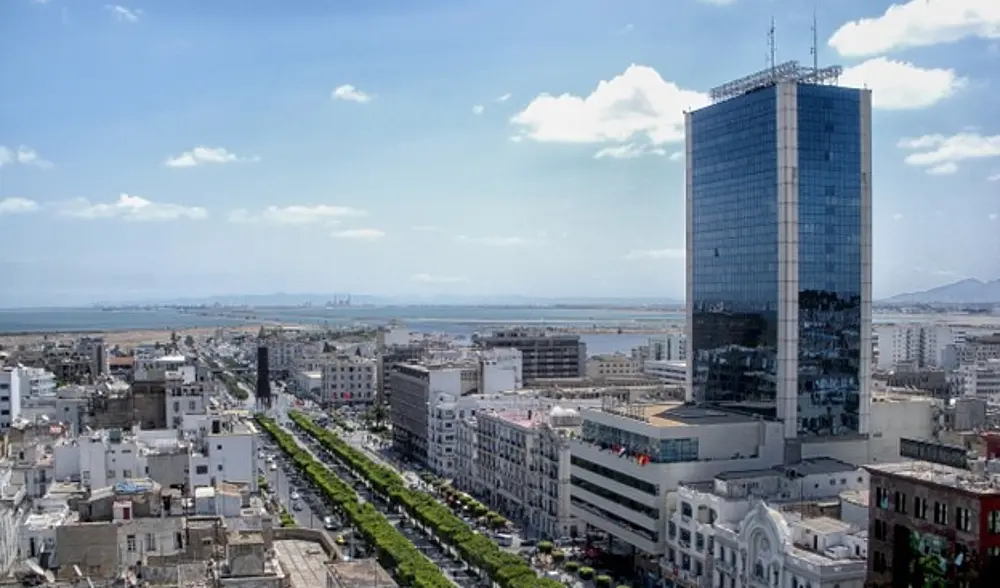When Water is an Energy Question: Energy Transition in Water-Scarce Tunisia

Water is essential, but for Tunisia it is increasingly scarce. With over 80% of its territory classified as arid to semi-arid, Tunisia ranks as the 30th most water-stressed nation globally (ITES, 2019). As natural water sources dwindle, desalination becomes a vital solution for the nation's cities, agriculture, and future. Although the practice is reliably deployed in many countries of its region, Tunisia is a net energy importer and relies heavily on imported gas to power its desalination plants (GIZ, 2021). This reliance not only strains the economy but also exposes it to global energy price fluctuations, putting further hurdles in Tunisia’s water question.
Water at the heart of the climate crisis
Water scarcity in Tunisia is chronic, with per capita water share dropping to just 377m3 in 2018, far below both the water poverty line of 1,700 cubic meters and the absolute scarcity threshold of 500 cubic meters (GIZ, 2021). The gap between existing capacity and future water demand has been apparent since 2000, but initial mitigation efforts were disrupted by the 2008 financial crisis and the Tunisian Revolution of 2011 (ITES, 2019). Currently in its fifth consecutive year of drought, Tunisia is facing a critical water crisis, worsened by unpredictable rainfall and seawater seeping into groundwater basins.
The World Bank (World Bank Group, 2023) has highlighted the economic ramifications of unresolved water shortages, projecting a potential reduction in Tunisia’s GDP by 3.4%, or TND 5.6 billion, annually by 2030, predominantly impacting the agricultural sector. According to the World Bank, this sector could see a decrease in value added of 15% by 2030 and 29% by 2050. Agricultural output in 2023 already fell significantly below expectations, which adversely affected the GDP growth forecast, reaching only 0.9% instead of the projected 2.3%. These factors could lead to annual economic losses of TND 1.8 billion, emphasizing the urgent need for strategic water management and policy interventions.
This analysis leverages crucial insights from two key documents developed by the Tunisian Institute for Strategic Studies (ITES): the Tunisie: Eaux 2050 (Tunisia: Water 2050) plan (2019) and the La Transition Énergétique Et Écologique En Tunisie À L’horizon 2050 report (2020). The first document focuses on demand-side projections and the significant impact of climate change on Tunisia’s water resources (ITES, 2019). It proposes two main scenarios that predict varying quality of life outcomes based on different economic development and environmental outcomes. The 2020 report extends these national scenarios to align with globally recognized climate models—RCP 4.5, RCP 8.5, RCP 6.5, and RCP 2.5 (ITES, 2020). This provides alignment with other models from the work of the World Bank (World Bank Group, 2023), Agence Française de Développement (AFD) (2023), and GIZ (2021), offering a robust platform for understanding how intertwined factors of climate policy and environmental management will shape Tunisia’s future water sustainability.
Energy Options for Sustainable Desalination
Approximately 95% of Tunisia’s electricity is currently generated from fossil fuels, mainly natural gas, 45% of which comes through imports (ITES, 2020). The country currently produces 39 million cubic meters (Mm³) of desalinated water annually, entirely reliant on natural gas systems. This dependency is projected to become increasingly unsustainable as ITES outlines scenarios under which desalination needs will skyrocket by 2050.
In the best-case scenario of sustainable development, dubbed the national accelerated efforts model, desalination capacity would need to increase to 376 Mm³ per year—a 607.69% rise from current levels, according to ITES (2019). Conversely, the more pessimistic reinforced tendency scenario foresees a troubling trajectory. This scenario assumes that current negative trends will continue, portraying a domestically failed environmental transition within a global context that fails to limit warming to 2°C. It predicts a surge in desalination requirements up to 713 Mm³/year, marking a staggering 1825.64% demand increase.
The study of existing desalination facilities in the region, as surveyed by Jungbin et al. (2019), shows that commercially viable projects in the region have an energy cost between 4.4 and 4 kWh/m3. For this blog, we will simplify by focusing on the 4 kWh/m3 that is achieved by large facilities. Based on this simplification, the energy demands for Tunisia's projected desalination needs under the sustainable development scenario could reach as much as 1,348 GWh, with a 55 million EUR annual energy cost based on the current energy mix and costs. Under the reinforced trajectory scenario, if Tunisia fails to have an ecological transition, our calculations point us to a daunting 2,852 GWh at a cost of 263 million EUR. The implications of such a scenario are profound, as meeting these water needs through conventional energy sources becomes untenable unless there is a major shift towards cheap, abundant, and clean energy solutions. As concluded by Boretti (2023), the progress toward net zero is challenging for countries that critically depend on desalination.
Renewable Energy, a Viable Alternative
Given Tunisia’s high solar irradiation—exceeding 2,000 kWh/m² per year—and an average of 3,000 sunshine hours annually, the country is ideally positioned to harness solar power for desalination (World Bank Group, 2023). Despite this potential, renewable energy production is minimal, totaling only about 467 megawatts from both wind and solar sources combined. According to the World Bank, the uptake of renewables has been slow, primarily due to financing hurdles.
A GIZ (2021) study of the energy needs of Tunisia’s water systems notes that Tunisia operates its existing desalination facilities on gas-powered combustion turbines. Yet, Tunisia’s drinking water production already suffers from energy inefficiency. Compared to the European median of 0.51 kWh per cubic meter of water consumption, SONEDE, the national water utility, averages 0.67 kWh/m3. Additionally, the limited number of desalination facilities commissioned by Tunisia in recent years has significantly increased the monetary cost of the energy required to produce a cubic meter of water. From 2015 to 2021, following the commissioning of gas-powered desalination plants in Tozeur, Kebili, Djerba, and Sousse, the average energy cost of drinking water rose from 0.82 TND/m³ to 1.30 TND/m³ (GIZ, 2021). This substantial increase highlights the financial burden associated with gas-powered desalination. Due to import dependence on gas, the unitary production costs have varied greatly over the years. For instance, in 2020, the average unit cost of gas-based electricity production was 0.081 EUR/kWh (World Bank Group, 2023). However, by 2022, amid the Russian gas crisis, this average unit cost surged to 0.1336 EUR/kWh, marking a 64.9% increase. In contrast, the market prices for renewable energy in Tunisia, derived from ongoing concessions, range from 0.034 to 0.054 EUR/kWh (GIZ, 2021), significantly undercutting the costs associated with gas. Therefore, gas-based desalination in Tunisia is not only relatively expensive, but continued dependence on fossil fuels also presents a vicious cycle, worsening both energy and water insecurity while increasing carbon emissions.
These data points highlight the urgent need for strategic investments in renewable energy in Tunisia, where the costs of financing wind and solar power remain high: according to the UNDP (2014), private investments totaling EUR 935 million are required just for the development of solar energy. Additionally, public funding is essential, especially for infrastructure and fiscal incentives, with estimated needs of EUR 642 million for wind and EUR 634 million for solar. However, despite these high initial costs, implementing rapid mitigation measures can significantly lower expenses. The UNDP recommends a financial package that includes derisking and demand control measures, which could reduce public investment costs in solar to EUR 276 million and eliminate the price premium for wind energy, with the package totaling EUR 275 million for wind and EUR 130 million for solar (2014; see also UNDP, 2018).
Conclusion
This blog shows that renewable energy is not only competitive in operational costs (GIZ, 2021) but also provides a stable and economically viable alternative to fossil-fuel-based systems (World Bank Group, 2023) for desalination. Investing in derisking renewable energy investments (UNDP, 2014) could therefore turn desalination into a sustainable solution for Tunisia's urgent water needs.
It is imperative for policymakers to integrate water and energy considerations into all aspects of planning and decision-making to facilitate this transition. As a first step, adapting the legal framework governing water use is crucial to reflect the true economic value of water in Tunisia. Currently, the economic return from one cubic meter of water in Tunisia does not exceed 14.38 USD, compared to 227.18 USD in Malta and 88.56 USD in the UAE (UN Water, 2021). This disparity does not necessarily mean that water is less productive in Tunisia, but rather that current demand-side practices do not reflect its real value. Recognizing this value is essential, as it will enable more effective cost-benefit analyses that can guide the choice of energy sources moving forward, paving the way for sustainable water management and energy use in Tunisia.
References
Boretti, A. (2023). The water-energy-environment-economy nexus progressing toward net zero. Water-Energy Nexus, 6, 13–17. https://doi.org/10.1016/j.wen.2023.06.003
Deutsche Gesellschaft für Internationale Zusammenarbeit (GIZ) & Ministry of Industry Mines and Energy. (2021). Study on the opportunities of “Power-to-X” in Tunisia. https://www.giz.de/en/downloads_els/GIZ%20PtX%20Tunisia%20report-Web.pdf
Institut Tunisien des Études Stratégiques (ITES). (2019). Tunisie: Eaux 2050. http://www.onagri.tn/uploads/Etudes/ITES-eau2050.pdf
Institut Tunisien des Études Stratégiques (ITES). (2020). La transition énergétique et écologique en Tunisie à l’horizon 2050. https://www.ites.tn/post/62330631f81409e3208f79d8
UNDP. (2014). TUNISIA: Derisking renewable energy investment. Selecting public instruments to promote renewable energy investments for the Tunisian solar plan NAMA (Summary Report). https://www.undp.org/sites/g/files/zskgke326/files/2022-09/DREI%20Tunisia%20Report_Summary_30Mar15.pdf
UNDP. (2018). Tunisia: Derisking renewable energy investment. https://www.undp.org/sites/g/files/zskgke326/files/publications/DREI%20Tunisia%202018%20Full%20Results%20(English)%20(Aug%202018)%20(FINAL).pdf
UNESCO World Water Assessment Programme (UN Water). (2021). The United Nations world water development report 2021: Valuing water. https://www.unesco.org/reports/wwdr/2021/en
World Bank Group. (2023). Tunisia: Country climate and development report. https://openknowledge.worldbank.org/server/api/core/bitstreams/fb44f7bf-242f-43fb-9c9b-d0d78900f290/content
Yilmaz, D., Ben-Nasr, S., Mantes, A., Ben-Khalifa, N., & Daghari, I. (2023). Climate change, loss of agricultural output and the macro-economy: The case of Tunisia (No. 286). Agence Française de Développement (AFD). https://www.afd.fr/en/ressources/climate-change-loss-agricultural-output-and-macro-economy-case-tunisia
About the Author

Houssem Chammam is a dedicated junior policy analyst and a current Master of Public Policy student at the University of Erfurt, focusing on Development and Socio-Economic Policies. After completing his undergraduate studies at Carleton College, Houssem returned to Tunisia to work with Al Bawsala, a leading civil society organization where he was deeply involved in public finance research and advocacy. An up-to-date, observant, and analytical professional, he is dedicated to understanding and addressing global issues.
~ The views represented in this blog post do not necessarily represent those of the Brandt School. ~